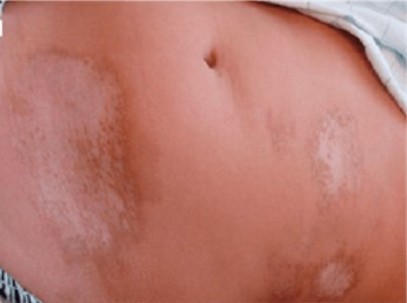(Morphea)
Localized form of scleroderma. Induration and cutaneous sclerosis are limited to fibrous bands located on the limbs or on the face (scleroderma or morphea "en coup de sabre"). The fibrous sclerosis can extend to the subcutaneous tissue, muscle and bone and cause significant deformations with atrophy of the limb or affected hemiface (Parry Romberg syndrome, see this term). Median age of onset of lesions: 10 years.
Neurological disorders are associated in 18 to 47 % of the cases and their appearance sometimes precedes the first cutaneous signs by a few months. These are: unilateral migraines with aura, seizures, transient hemiparesis, personality changes.
Treatment: methotrexate, according to the associated neurological disorders.

Anesthetic implications:
Are related to the location of the lesion (sometimes deformation or atrophy). Side effects of the medical treatment (local steroids, methotrexate, PUVA therapy...). Associated neurological problems: migraine, epilepsy. Look for sometimes subtle signs of systemic involvement (esophagus, pulmonary hypertension)
References :
- Polcari I, Moon A, Mathes E, Gilmore ES, Paller AS.
Headaches as a presenting symptom of linear Morphea « en Coup de sabre ».
Pediatrics 2014 ; 134 : e1715-9.
- Legendre L, Cuinat L, Curot J, Tanchoux F,
Bonneville F, Mazereeuw-Hautier J.
Sclérodermie linéaire de la face associée à des anomalies neurologiques par microangiopathie.
Ann Dermatol Vénéréol 2016 ; 143 : 831-5
Updated: March 2023